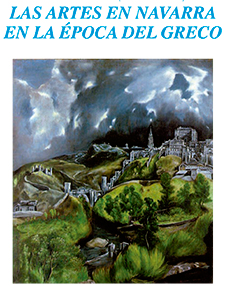AROUND THE 4TH CENTENARY OF EL GRECO (1541-1614). THE ARTS IN NAVARRA IN THE AGE OF EL GRECO
September 5, 2013
Rolan Moys and the beginnings of Counter-Reformation painting in Navarre.
Mr. Jesús Criado Mainar. University of Zaragoza
The celebration of the Council of Trent (1545-1563) meant the introduction of notable changes in the doctrinal strategy of the Catholic Church to face the criticisms of the Reformation, which were immediately transferred to architecture and the plastic arts of purpose religious. This phenomenon, characteristic of Italian art and in which artistic literature played a primordial role, spread in the final decades of the 16th century to other Catholic states, in particular to the Hispanic Monarchy of Philip II (1556-1598) and Philip III (1598-1621). In the area of the Ribera de Navarre, at that time mostly under the Diocese of Tarazona and subject to a strong Aragonese influence, the renovation of sacred art in the Counter-Reformationist core topic is manifest in the field of painting and has a fundamental episode in the commissioning of the major altarpieces of the Cistercian monasteries of La Oliva (1571-1587) -in the Merindad de Olite- and Fitero (1590-1591). The first was begun by the Flemish Rolan Moys (doc. 1571-1592, †1592) and Paulo Scheppers (doc. 1565-1576, †1577), although the premature death of the latter obliged the former to continue the commission from 1577. Years later, Moys was already working alone on the Fitero altarpiece.
According to the treatise writer Jusepe Martínez, Scheppers and Moys arrived in Aragon around 1559 by the hand of Martín de Gurrea, IV Duke of Villahermosa: the first, a native of Mechelen, to serve him as "painter of stories" and the second, a native of Brussels, to create a gallery of portraits of this illustrious lineage. Years later Scheppers moved to Naples, where he worked between 1564-1565 and 1571, among other commitments in the decoration of the dome of the church of Saints Severino and Sossio in that city. Moys also traveled to Italy, apparently with the assignment of acquiring paintings for the Duke of Villahermosa, and we know that he was in Rome in April 1571.
Once they returned to Zaragoza, Scheppers and Moys undertook the realization of the altarpiece of La Oliva, acting as mediator the Duke Don Martin. This great conjunct-to supposes the introduction in the painting of the middle valley of the Ebro of the "thin and very gentle" way of the Flemish school united to the new models of the Counter-Reformation from the Neapolitan creations of framework Pino, who coincided with Scheppers in the ornamentation of the Saints Severino and Sossio. Even before its installation in 1587, the altarpiece of La Oliva became a work of reference letter for the painting of Navarre and Aragon. The early death of Scheppers has justified that traditionally Moys has been granted a preponderant role in this society, but the recent finding of a panel signed and dated in 1575 by the Malinese of Our Lady of the Pillar between St. James the Apostle and a devotee of the Society of Jesus has allowed to reverse the terms of the proposition and to correctly assess his contribution.
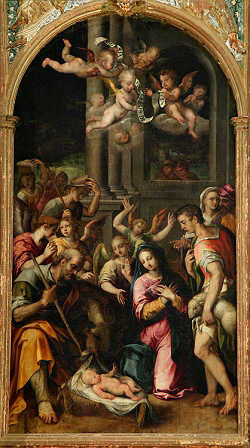
Paulo Scheppers, Adoration of the shepherds
High Altarpiece of the Monastery of La Oliva
(Nowadays in the parish church of San Pedro de Tafalla)
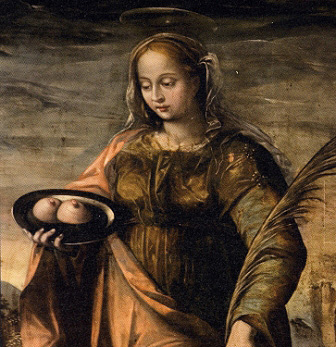
Rolan Moys, Saint Agatha. Detail
Main altarpiece of the monastery (present parish) of Fitero.
Beyond the importance of the personal creations of the Duke of Villahermosa's painters in La Oliva, Fitero and even Cascante, it is interesting to recall the role of his disciples in the diffusion of his models and, to a lesser extent, of his refined style. Antón Galcerán (act. 1578-1614) and Francisco Metelín el Joven (act. 1573-1614, †1614) were trained in Moys' workshop. The former worked in Tudela as early as 1587, but the most important thing is that Metelín settled in Tarazona in 1588, and from there he carried out numerous commissions in the Episcopal see and in localities of the deanery of Tudela.
Completing the trio is the Navarrese Juan de Lumbier (act. 1579-1626, †1626), trained in Zaragoza with Pedro Pertús el Joven and settled in Tudela from 1582, who dominated the artistic scene in Tudela for several decades. Unlike Galcerán and Metelín, Lumbier cannot be considered a direct follower of Moys but, beyond this fact, he was undoubtedly the one who best knew how to make use of the novelties of his style to create a simple and highly effective plastic language with which he dominated the painting of La Ribera throughout the first third of the 17th century while playing a not inconsiderable role in the neighboring Aragonese regions of Tarazona and Borja, where a significant part of his production is preserved.
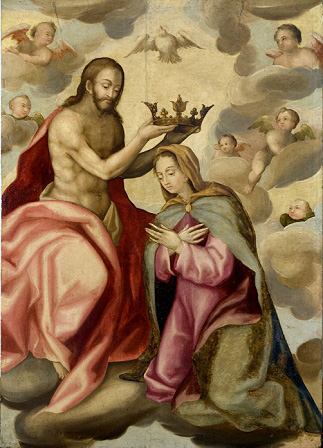
Juan de Lumbier, Coronation of the Virgin Mary
Borja
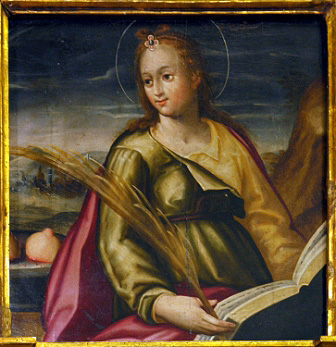
Juan de Lumbier, Santa Águeda
Cortes
PROGRAM
Tuesday, 3rd September
El Greco on his 4th Centenary
Ana Carmen Lavín Berdonces. Director of the El Greco Museum
El Greco and Toledo
Ms. Ana Carmen Lavín Berdonces. Director of the El Greco Museum
Wednesday, 4th September
Of patrons and artists
D. Ricardo Fernández Gracia. Chair of Heritage and Art of Navarre
Juan de Anchieta: a genius of sculpture
Ms. María Concepción García Gainza. Chair of Navarrese Heritage and Art
Thursday, 5th September
Rolan Mois and the beginnings of Counter-Reformation painting in Navarre
Mr. Jesús Criado Mainar. University of Zaragoza
The silversmith Velázquez de Medrano and micro-architecture in silver
D. Ignacio Miguéliz Valcarlos. UNED Pamplona

